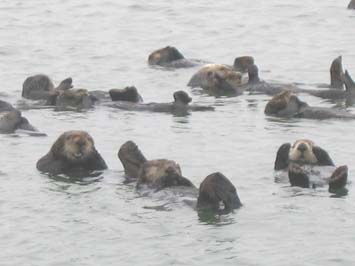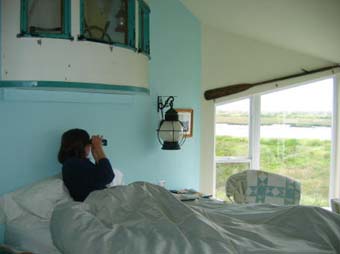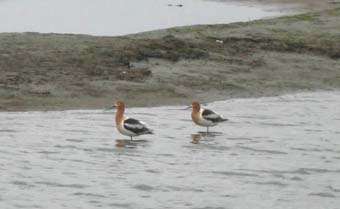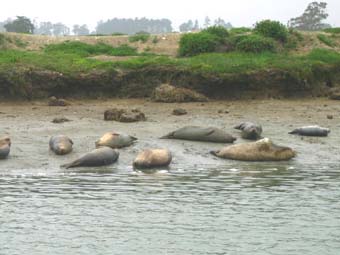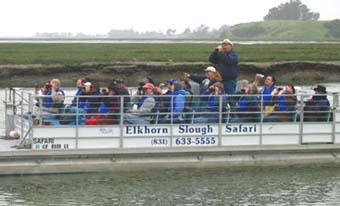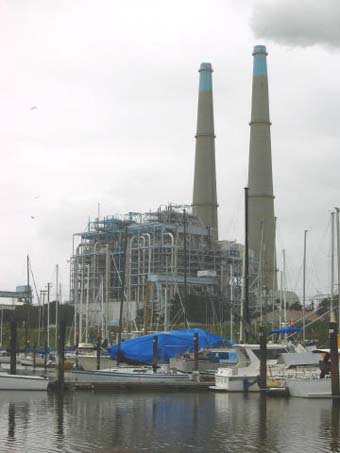|
|
Mighty
Moss: From miles away we could see the two towering smokestacks that dominate the town and send a constant river of smoke — the locals prefer to call it clean steam — wafting across the landscape. Undeterred, we drove on through endless fields of artichokes and strawberries toward Moss Landing, a small town a few miles north of Monterey, California. Often overlooked by the tourist hordes, we were to discover that Moss Landing is a hidden jewel, and like a book and its cover, should not be judged on first appearances. |
|||||
We drove direct to Captain’s Inn, a historic bed & breakfast that was to serve as our base. Our friendly hostess, Melanie Gideon, gave a tour of the establishment, which was built in 1906 following the San Francisco earthquake. The Inn is a virtual maritime museum full of nautical whimsy. Several guest rooms are fashioned from boats. Our room, the High Seas, for example, featured the salmon troller, San Pedro: the body of the boat forms the bed, the prow of the boat is a side table and the wheelhouse, complete with wheel and map, is mounted above the bed. A huge double tub is set against the windows that run along the entire wall overlooking the marshes and river — a wildlife and bird paradise. Next morning we were awakened by the trill and chirp of birds. The Inn has a contest for identifying bird species — the catch is that you cannot leave bed and must be down for breakfast before 9:00 am. Even with the aid of binoculars my wife and I could not come near the record of 37. Melanie explained that the serious contestants set up tripods and telescopes right in bed! We tumbled down to a gourmet breakfast featuring Kona coffee, a visually stunning fruit salad with mango and fresh strawberries, a cinnamon scone, and then dozens of prawns and avocado in scrambled eggs. Allyson set off for shopping with gusto for Moss Landing is renowned for its antique stores. With over 20, this tiny town boasts the highest number per capita in the country. Meanwhile I visited Phil’s fish market and strolled leisurely along the beach and harbour. Everywhere I was under the pall of the giant smoke stacks, a constant reminder that California’s burgeoning population desperately needs energy, as pumped out by this enormous natural-gas power plant known as “Mighty Moss.” In the afternoon, we embarked on a tour of the Elkhorn Slough. Nature lovers come from around the world to visit this 1400-acre estuary, one of California’s largest wetlands, which teems with marine and bird life. Designated as a Globally Important Bird Area, it is one of the ten top birding areas in the USA. Captain Yohn Gideon, Melanie’s husband — bedecked in nautical attire — welcomed us aboard his pontoon boat and soon we were puttering out of the busy harbour, which is the largest fishing port on Monterey Bay and home to 400 fishing boats. Hand-held clickers were assigned to passengers so we could count various animals and birds; Allyson, was in charge of harbour seals. (These data have been accumulated over many years and help research centres study wildlife in the slough.) We passed a fishing boat unloading squirming masses of anchovies. Almost immediately, the enormous richness of marine life in this estuary became apparent. We passed dozens and dozens of sea lions, some sleeping in small groups with flippers protruding from the water like small black sails. An old trestle loomed by, bedecked with cormorants several with their black wings outstretched like preachers blessing our boat. We puttered a bit deeper into the slough when suddenly Captain Yohn pointed to a large group of animals sleeping and playing in the water. It was a raft of about 60 sea otters, looking ever so cute with their whiskers and cuddly fur. During the fur trade of the 18th and 19th centuries, southern sea otters were hunted to near extinction and today they remain on the endangered species list. This group — one of largest witnessed by Captain Yohn in over a decade — represented a significant fraction of the approximately 2000 otters along the entire California coast. To top it off, a little later, on hearing a clack-clack-clack, we looked to the port side. There was an otter swimming on its back while trying to break open a clam with a rock on its chest. There was a constant glinting of binoculars and clicking of counters for the slough is a smorgasbord of birds including pelicans, sandpipers, egrets, avocets, godwits, curlews, herons and loons. It was enjoyable and educational even for novice birders as Tera, the naturalist first mate, described the various birds and animals we encountered and passed around photos and information sheets. In total, we spotted 45 different bird species. “You’ll have to come back again, for that’s only a small part of the over 300 species that have been identified in the Slough,” said Captain Yohn. The most unusual birds the Captain has seen include a yellow-billed loon, an emperor’s goose and a laughing gull. The hours passed like minutes and all too soon we puttered back to port and the captain recorded the final tally. We had seen 41 sea lions, 87 otters and 175 harbour seals. With an enormous variety of fresh seafood arriving every day, dinner at Charlie Moss’ Restaurant that evening was, as expected, outstanding. Here, near the “artichoke capital of the world,” the menu featured about 10 artichoke starters including deep-fried, Provençal with prawns and scallops, and — our choice — fire-roasted artichoke with herb aioli. Allyson enjoyed Ahi tuna with hoisin and wasabi sauce and blackened shrimp, while I donned a bib and feasted on a huge bowl of ciopinno with lobster, crab, prawns, calamari, fish and more in a cinnamon-flavoured tomato sauce. We waddled contentedly back to our fishing-boat
bed already anticipating the morning’s bird count.
|
If You Go
For more information on the Monterey Bay area, read Hans's article Monterey, California: Exulting in Nature and History |
|||||
